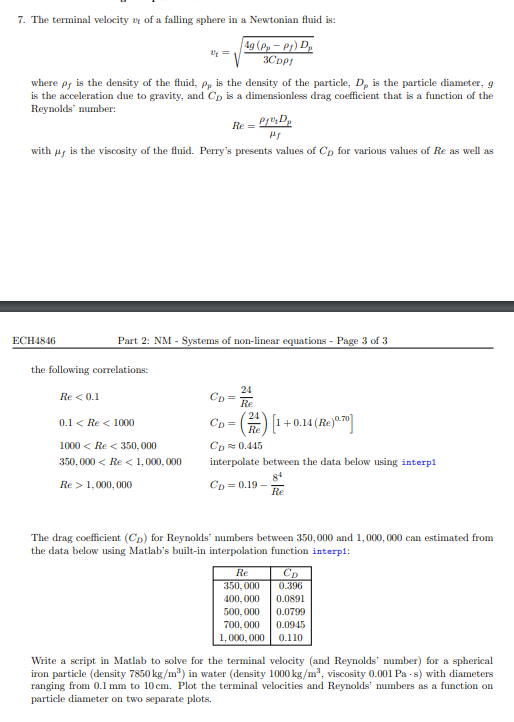Home /
Expert Answers /
Chemical Engineering /
7-the-terminal-velocity-v-t-of-a-falling-sphere-in-a-newtonian-fluid-is-v-t-sqrt-pa759
(Solved): 7. The terminal velocity \( v_{t} \) of a falling sphere in a Newtonian fluid is: \[ v_{t}=\sqrt{\ ...
7. The terminal velocity \( v_{t} \) of a falling sphere in a Newtonian fluid is: \[ v_{t}=\sqrt{\frac{4 g\left(\rho_{p}-\rho_{f}\right) D_{p}}{3 C \rho_{f}}} \] where \( \rho_{f} \) is the density of the fluid, \( \rho_{p} \) is the density of the particle, \( D_{p} \) is the particle diameter, \( g \) is the acceleration due to gravity, and \( C_{D} \) is a dimensionless drag coefficient that is a function of the Reynolds' number: \[ R e=\frac{\rho_{f} \nu_{t} D_{p}}{\mu_{f}} \] with \( \mu_{f} \) is the viscosity of the fluid. Perry's presents values of \( C_{D} \) for various values of \( R e \) as well as \( \mathrm{ECH} 4846 \) Part 2: NM - Systems of non-linear equations - Page 3 of 3 the following correlations: \[ \begin{array}{ll} R e<0.1 & C_{D}=\frac{24}{R e} \\ 0.11,000,000 & C_{D}=0.19-\frac{8^{4}}{R e} \end{array} \] The drag coefficient \( \left(C_{D}\right) \) for Reynolds' numbers between 350,000 and \( 1,000,000 \) can estimated from the data below using Matlab's built-in interpolation function interp1: Write a script in Matlab to solve for the terminal velocity (and Reynolds' number) for a spherical iron particle (density \( 7850 \mathrm{~kg} / \mathrm{m}^{3} \) ) in water (density \( 1000 \mathrm{~kg} / \mathrm{m}^{3} \), viscosity \( 0.001 \mathrm{~Pa} \cdot \mathrm{s} \) ) with diameters ranging from \( 0.1 \mathrm{~mm} \) to \( 10 \mathrm{~cm} \). Plot the terminal velocities and Reynolds' numbers as a function on particle diameter on two separate plots.
Expert Answer
Matlab Code: clc clear Dw=1000; %Density of water in kg/m^3 Dp(1)=7850; %Density of particle(iron) in kg/m^3 U=1e-3; %Viscosity in kg
